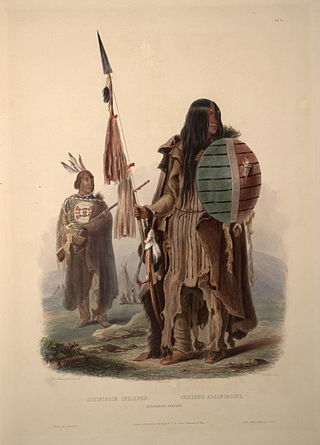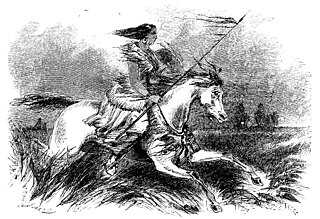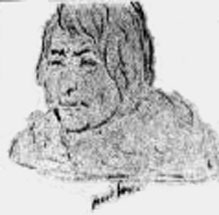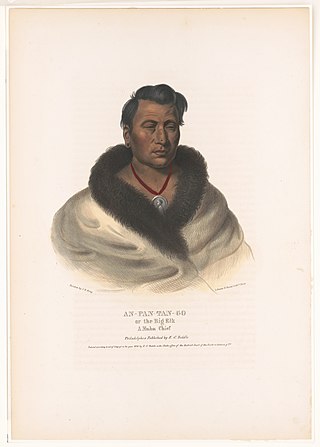
The Crow, whose autonym is Apsáalooke, also spelled Absaroka, are Native Americans living primarily in southern Montana. Today, the Crow people have a federally recognized tribe, the Crow Tribe of Montana, with an Indian reservation, the Crow Indian Reservation, located in the south-central part of the state.

Toussaint Charbonneau was a French Canadian explorer, fur trapper and merchant who is best known for his role in the Lewis and Clark Expedition as the husband of Sacagawea.
Billy Caldwell, baptized Thomas Caldwell, known also as Sauganash, was a British-Potawatomi fur trader who was commissioned captain in the Indian Department of Canada during the War of 1812. He moved to the United States in 1818 and settled there. In 1829 and 1833, he negotiated treaties on behalf of the United Nations of Chippewa, Ottawa and Potawatomi with the United States, and became a leader of a Potawatomi band at Trader's Point. He worked to gain the boundary long promised by the British between white settlers and Indians, but never achieved it.

The Assiniboine or Assiniboin people, also known as the Hohe and known by the endonym Nakota, are a First Nations/Native American people originally from the Northern Great Plains of North America.

Fort Union Trading Post National Historic Site is a partial reconstruction of the most important fur trading post on the upper Missouri River from 1829 to 1867. The fort site is about two miles from the confluence of the Missouri River and its tributary, the Yellowstone River, on the Dakota side of the North Dakota/Montana border, 25 miles from Williston, North Dakota.

Bíawacheeitchish, in English Woman Chief, was a bacheeítche (chief) and warrior of the Crow people. Interested in traditionally male pursuits from an early age, she became one of the Crows' most significant leaders, joining the Council of Chiefs as the third ranking member. She attracted substantial attention from Western visitors; she may be the same person as "Pine Leaf" described by James Beckwourth, though the accuracy of this account is challenged.

Crazy Bear (1785–1856) was a chief of the Assiniboine tribes of the northern plains. Their territory included Montana, North Dakota, Alberta and Saskatchewan. He is known as a skilled negotiator with the American Fur Company at Fort Union, North Dakota, and remembered for his participation and representation at the Fort Laramie Treaty Council of 1851—where he was a signatory of the treaty. He earned the name Mah-To-Wit-Ko because he fought like a crazy bear. Wit-Ko is a Siouan word that has multiple translations: crazy, foolish, frightening and mad. Crazy Bear has been recorded by these names and also in French as Ours Fou.
Angus Bethune was the oldest son of the Reverend John Bethune. He had several distinguished brothers: Alexander Neil, who became Anglican bishop of Toronto; John, Anglican clergyman, dean of the diocese of Montreal and principal of McGill University; James Gray prominent Upper Canada businessman; Donald, an important political figure in Upper Canada.
Fort Lisa (1812–1823) was established in 1812 in what is now North Omaha in Omaha, Nebraska by famed fur trader Manuel Lisa and the Missouri Fur Company, which was based in Saint Louis. The fort was associated with several firsts in Nebraska history: Lisa was the first European farmer in Nebraska; it was the first settlement by American citizens set up in the then-recent Louisiana Purchase; Lisa's wife was the first woman resident of European descent in Nebraska; and the first steamboat to navigate Nebraska waters, the Western Engineer, arrived at Fort Lisa in September 1819.
The Sakāwithiniwak or Woodland Cree, are a Cree people, calling themselves Nîhithaw in their own dialect of the language. They are the largest indigenous group in northern Alberta and are an Algonquian people. Prior to the 18th century, their territory extended west of Hudson Bay, as far north as Churchill. Although in western Northern Saskatchewan and Manitoba, by the 18th century, they acted as middlemen in trade with western tribes. After acquiring guns through trade, they greatly expanded their territory and drove other tribes further west and north.
The 1837 Great Plains smallpox epidemic spanned 1836 through 1840 but reached its height after the spring of 1837, when an American Fur Company steamboat, the SS St. Peter, carried infected people and supplies up the Missouri River in the Midwestern United States. The disease spread rapidly to indigenous populations with no natural immunity, causing widespread illness and death across the Great Plains, especially in the Upper Missouri River watershed. More than 17,000 Indigenous people died along the Missouri River alone, with some bands becoming nearly extinct.

Big Elk, also known as Ontopanga (1765/75–1846/1848), was a principal chief of the Omaha tribe for many years on the upper Missouri River. He is notable for his oration delivered at the funeral of Black Buffalo, the maternal grandfather of Crazy Horse, in 1813.

Rudolph Friedrich Kurz (1818–1871) was a Swiss painter and writer who traveled to the United States in order to paint and study the Native Americans. He is mostly known on account of his journals, in which he presents an account of and an interesting commentary on life in the mid-19th century along the Mississippi and upper Missouri rivers.

John Canfield Ewers was an American ethnologist and museum curator. Known for his studies on the art and history of the American Plains Indians, he was described by The New York Times as one of his country's "foremost interpreters of American Indian culture."
The Iron Confederacy or Iron Confederation was a political and military alliance of Plains Indians of what is now Western Canada and the northern United States. This confederacy included various individual bands that formed political, hunting and military alliances in defense against common enemies. The ethnic groups that made up the Confederacy were the branches of the Cree that moved onto the Great Plains around 1740, the Saulteaux, the Nakoda or Stoney people also called Pwat or Assiniboine, and the Métis and Haudenosaunee. The Confederacy rose to predominance on the northern Plains during the height of the North American fur trade when they operated as middlemen controlling the flow of European goods, particularly guns and ammunition, to other Indigenous nations, and the flow of furs to the Hudson's Bay Company (HBC) and North West Company (NWC) trading posts. Its peoples later also played a major part in the bison (buffalo) hunt, and the pemmican trade. The decline of the fur trade and the collapse of the bison herds sapped the power of the Confederacy after the 1860s, and it could no longer act as a barrier to U.S. and Canadian expansion.

The fur trade in Montana was a major period in the area's economic history from about 1800 to the 1850s. It also represents the initial meeting of cultures between indigenous peoples and those of European ancestry. British and Canadian traders approached the area from the north and northeast focusing on trading with the indigenous people, who often did the trapping of beavers and other animals themselves. American traders moved gradually up the Missouri River seeking to beat British and Canadian traders to the profitable Upper Missouri River region.
Marriage à la façon du pays refers to the practice of common-law marriage between European fur traders and aboriginal or Métis women in the North American fur trade. One historian, Sylvia Van Kirk, suggested these marriages were "the basis for a fur trade society". The practice persisted from the early seventeenth century until the late nineteenth century. It has been suggested that it fell out of practice due to increasing pressures of Catholic ideology and a growing population of non-indigenous women including the new generation of "mixed-breed" daughters who eventually replaced their native mothers as fur traders' wives. Rituals surrounding the marriages were based on a mix of European and, predominantly, Indigenous customs.

Charles Larpenteur (1803-1872) was an American fur trader whose memoir and diary frequently have been used as sources about fur trade history.

Alexander Culbertson (1809–1879), was an American fur trader who founded Fort Benton, Montana, and was a special government agent who played an important role in the negotiations leading to the 1851 treaty of Fort Laramie. Later, Culbertson and his wife Natawista Iksina negotiated with the Blackfoot Confederacy to let the northern Pacific railroad survey of 1853 continue unharmed.

Joseph Marie LaBarge was an American steamboat captain, most notably of the steamboats Yellowstone, and Emilie, that saw service on the Mississippi and Missouri rivers, bringing fur traders, miners, goods and supplies up and down these rivers to their destinations. During much of his career LaBarge was in the employ of the American Fur Company, a giant in the fur trading business, before building his own steamboat, the Emilie, to become an independent riverman. During his career he exceeded several existing speed and distance records for steamboats on the Missouri River. Passengers aboard his vessels sometimes included notable people, including Abraham Lincoln. LaBarge routinely offered his steamboat services gratis to Jesuit missionaries throughout his career.













